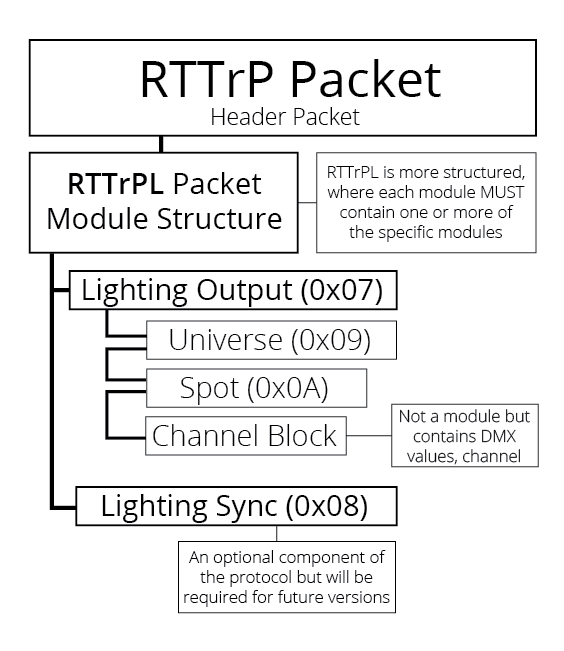Information
RTTrPL is used to stream lighting fixture and DMX information to third parties interested in overwriting fixture DMX values sent from a lighting console, for control over said fixtures. RTTrPL output should be triggered by motion data, DMX input, show starting/stopping, and third party requests. As such, it should not send at a fixed rate like the RTTrPM protocol.
Data Structures

An RTTrPL packet is a list of universes, each of which contains a nested list of spots (fixture IDs), which further contain a nested list of channels and their values:
- Controlled Universe
- Controlled Fixtures within each Universe
- Channels to be controlled
- DMX Values of controlled channels
General Information
- In general the Peer is responsible for DMX merging
- The Peer buffer and RTTrPL generating buffer need to be synchronized
- Synchronization model: Snapshot / Update, which balances performance and implementation difficulty
- Snapshot and Update share the same packet format, the type should be indicated by the Action field in the Lighting Output module
- Snapshot contains all channels of all universes that are being controlled while Update changes only a portion of the buffer
- An Update may contain one or more universes
- Hold Time controls when to release the buffer, if a timeout ouccurs, the Peer should release its buffer
- Out of Sync detection: Lighting Sequence in Lighting Output module is a sequentially increasing number, if the Peer receives packets out of sequence, it should wait for a Snapshot packet from the generator to re-sync
Downloads
The RTTrP Repository has stub code available which contains packet definitions of RTTrPL. Please visit the following for Python and C++ code respecitvely:
Modules and Packet Structure
Packet Modules
| Enumerated Type | Value |
|---|---|
| Lighting Output | 0x07 |
| Universe | 0x09 |
| Spot | 0x0A |
Real-Time Tracking Protocol (RTTrP) Header
| Field | Name | Type | Size (bytes) | Description |
|---|---|---|---|---|
| 0 | Header / Integer Signature | UInt16 | 2 | Big Endian: 0x4154, Little Endian: 0x5441 |
| 1 | Header / Float Signature | UInt16 | 2 | Big Endian: 0x4434, Little Endian: 0x3444 |
| 2 | Header Version | UInt16 | 2 | Value = 0x0003, will increase if header changes |
| 3 | Packet ID | UInt32 | 4 | Packet sequence number |
| 4 | Packet Format | UInt8 | 1 | Value = 0x00 (Raw), 0x01 (Protobuf), 0x02 (Thrift) |
| 5 | Size | UInt16 | 2 | Size of packet in bytes including header |
| 6 | Context | UInt32 | 4 | User definable |
| 7 | Number of Packet Modules | UInt8 | 1 | |
| 8 | Packet Module 0 | Packet Module | Variable | |
| 9 | Packet Module 1 | Packet Module | Variable | |
| ... | ... |
For more in-depth details on the RTTrP packet header see RTTrP.
Packet Module - Lighting Output
| Field | Name | Type | Size (bytes) | Description |
|---|---|---|---|---|
| 0 | Type | UInt8 | 1 | Value = 0x07 |
| 1 | Size | UInt16 | 2 | Size of packet module including type and size |
| 2 | Lighting Sequence | UInt32 | 4 | Lighting session sequence. Starting from 0 |
| 3 | Action | UInt8 | 1 | 0x00: snapshot; 0x01: update |
| 4 | Hold Time | UInt32 | 4 | 0x00: Do not release automatically; > 0 milliseconds before releasing |
| 5 | Number of Universe Modules | UInt16 | 2 | |
| 6 | Packet Module 0 | Packet Module | Variable | |
| 7 | Packet Module 1 | Packet Module | Variable | |
| ... | ... |
Packet Module - Universe Module
| Field | Name | Type | Size (bytes) | Description |
|---|---|---|---|---|
| 0 | Type | UInt8 | 1 | Value = 0x09 |
| 1 | Size | UInt16 | 2 | Size of packet module including type and size |
| 2 | Universe ID | UInt16 | 2 | |
| 3 | Number of Spot Modules | UInt16 | 2 | |
| 4 | Spot Module 0 | Packet Module | Variable | |
| 5 | Spot Module 1 | Packet Module | Variable | |
| ... | ... |
Packet Module - Spot Module
| Field | Name | Type | Size (bytes) | Description |
|---|---|---|---|---|
| 0 | Type | UInt8 | 1 | Value = 0x0A |
| 1 | Size | UInt16 | 2 | Size of packet module including type and size |
| 2 | Spot ID | UInt16 | 2 | Fixture ID |
| 3 | Spot Offset | UInt16 | 2 | Location of the byte offset in a universe |
| 4 | Number of Channel Structures | UInt16 | 2 | |
| 5 | Channel Block 0 | Variable | ||
| 6 | Channel Block 1 | Variable | ||
| ... | ... |
NOTE: The Spot ID field refers to the Fixture ID
Channel Block (Fixed-Size)
| Field | Name | Type | Size (bytes) | Description |
|---|---|---|---|---|
| 0 | Channel Offset | UInt16 | 2 | Locate the byte offset in Spot (not universe) |
| 1 | Xfade | UInt16 | 2 | 0.00% -- 100.00% (fade / 100) (Could be wrong if cross-channel values are used) |
| 2 | Value | UInt8 | 1 | DMX channel value |